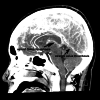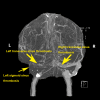Nitrous Oxide-Induced Cerebral Venous Thrombosis: A Case Report, Potential Mechanisms, and Literature Review
- PMID: 37546135
- PMCID: PMC10403680
- DOI: 10.7759/cureus.41428
Nitrous Oxide-Induced Cerebral Venous Thrombosis: A Case Report, Potential Mechanisms, and Literature Review
Abstract
Cerebral venous thrombosis can result from hypercoagulation, either genetic or acquired. Hyperhomocysteninemia was previously thought to be linked with thrombophilia, although this is still controversial to this present day. In recent years, there has been a notable surge in the recreational use of nitrous oxide, which could potentially lead to hyperhomocysteinemia. We present a case of a 19-year-old female who was diagnosed with cerebral venous thrombosis with intracerebral hemorrhage. She had a history of nitrous oxide abuse, which is known to cause dysfunction of vitamin B12. Additionally, we conducted a literature review of cerebral venous thrombosis following nitrous oxide usage. Investigation showed that her serum vitamin B12 level was <100 pg/mL (reference range 197-771 pg/mL), and homocysteine level was 100.6 µmol/L (reference range 5.0-15.0 µmol/L). After receiving a vitamin B12 supplement, both serum vitamin B12 and homocysteine levels returned to normal. No other risk factors for thrombophilia were detected. Previously reported cases predominantly demonstrated hyperhomocysteinemia. The most likely mechanism of her cerebral venous thrombosis was hyperhomocysteinemia due to vitamin B12 deficiency caused by nitrous oxide abuse. This finding supports the hypothesis that hyperhomocysteinemia can induce cerebral venous thrombosis.
Keywords: cerebral venous thrombosis; cobalamin; homocysteine; nitrous oxide; vitamin b12.
Copyright © 2023, Banjongjit et al.
Conflict of interest statement
The authors have declared that no competing interests exist.
Figures




References
-
- Cerebral venous thrombosis: a practical guide. Ulivi L, Squitieri M, Cohen H, Cowley P, Werring DJ. Pract Neurol. 2020;20:356–367. - PubMed
-
- Hyperhomocysteinemia and risk of first venous thrombosis: the influence of (unmeasured) confounding factors. Ospina-Romero M, Cannegieter SC, den Heijer M, Doggen CJ, Rosendaal FR, Lijfering WM. Am J Epidemiol. 2018;187:1392–1400. - PubMed
-
- Homocysteine levels in patients with deep vein thrombosis lacking thrombophilic defects. Vayá A, Gómez I, Mira Y, Ferrando F, Corella D. Thromb Haemost. 2008;99:1132–1134. - PubMed
-
- The risk of venous and arterial thrombosis in hyperhomocysteinaemia is low and mainly depends on concomitant thrombophilic defects. Lijfering WM, Coppens M, van de Poel MH, et al. Thromb Haemost. 2007;98:457–463. - PubMed
-
- Vitamin B(12) , folate, and the methionine remethylation cycle-biochemistry, pathways, and regulation. Froese DS, Fowler B, Baumgartner MR. J Inherit Metab Dis. 2019;42:673–685. - PubMed
Publication types
LinkOut - more resources
Full Text Sources
